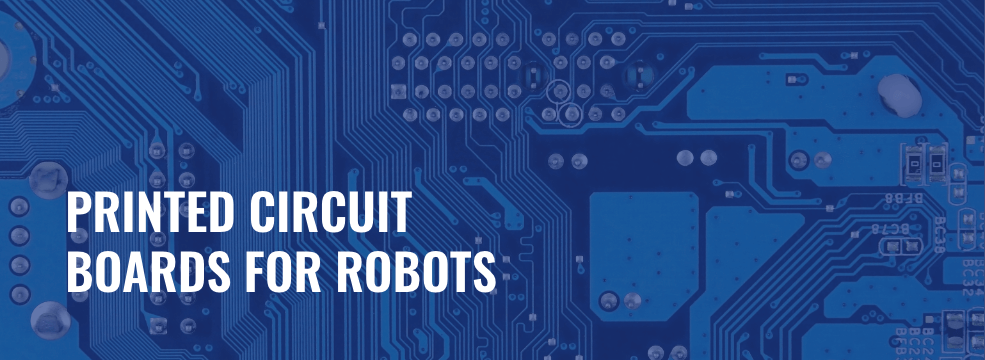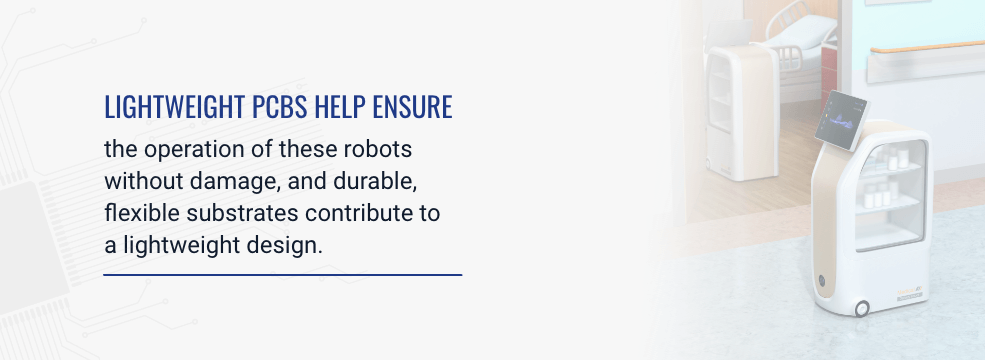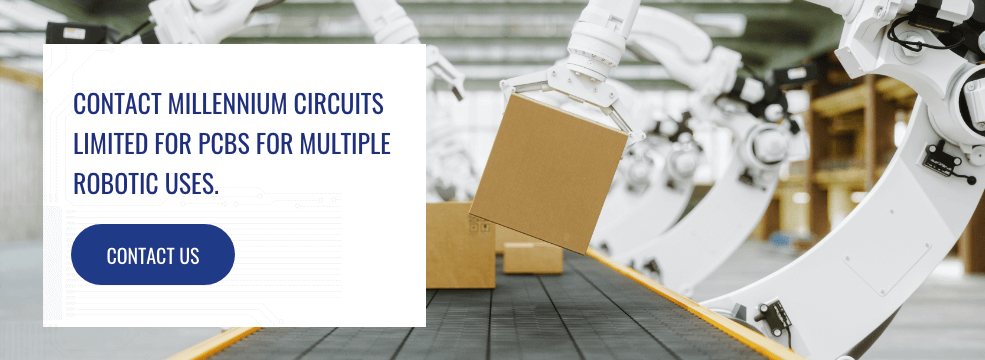Printed Circuit Boards for Robots
Automation today requires the use of robots and their electronic components. Among the most important aspects of robotics is the printed circuit board (PCB) used for electronic control and operation. With multiple industries that use robotics, finding PCB solutions that meet the various needs of the automated devices has become even more valuable.
The circuit board provides the control system and is one of five major components of a robot to ensure its operation. The other major parts of a robot are the sensors, actions and feedback, body and power supply. Since the PCB must work to control the robot, robot builders cannot compromise on the design and structure of the PCB.
Get Pricing and Lead Time Call 717-558-5975
Design Considerations for PCBs for Robotics
The PCB starts with a schematic. This design phase is crucial for outlining the components and arrangement on the circuit board. Be specific when designing the PCB to avoid problems during the evaluation or manufacturing phases. Various considerations during design include the trace width, drill size and package design.
Trace Width
The trace width determines the space available for carrying current. Both power and ground lines use traces. And both should have sufficient width. Additionally, you should not create any layouts that require sharp, 90-degree turns in the traces.
Without a wide enough trace size, heat damage can occur to the components on the PCB. However, trace size should not be so wide as to interfere with other components on the PCB. Various tools for designing PCBs can help you calculate the necessary width for traces on the board.
Drill Size
The drill size dictates the width of holes cut into the PCB. However, when indicating the appropriate drill size on your diagram, do not use the distance needed. Increase it slightly. Solder will fill some of the space, reducing the required drill size and making up for any discrepancies between the space needed and the hole.
Additionally, plan to ensure that drill holes are not closer to traces, planes or pads than 0.010 inches. Also, drill holes should not be smaller than 0.008 inches in diameter.
Package Design
During design, make sure to understand the view created of the package. Generally, you want to produce a bottom view of the PCB package. If using it on top, mirror the design to ensure the symmetry of components.
Due to limited space on the package, consider using both sides. For example, place surface mounted devices on the bottom and through hole components on top. Additionally, use more compact connectors to save space, if needed.
Challenges for Robotic Circuit Boards
There are multiple challenges for robotic circuit boards to ensure they operate properly. To ensure the operation of the robots, the PCBs must have high quality. Avoiding risks is crucial, especially for robotic applications that put people’s lives or safety at risk.
Quality
Quality of the PCB means using a board that follows a quality assurance process during manufacturing. Look for ISO 9001:2015 certification from the PCB provider. Your robotic PCB supplier should also adhere to industry-specific certification requirements, such as IPC-6012 and IPC-A-600. Conforming to established standards helps to ensure the quality of the completed boards.
Risk Management in Design
Mitigating risks from the PCB is another challenge for robotics. Examining the board’s design to ensure manufacturability and avoid problems is essential. For instance, a design review before engineering with the Design Rule Check ensures the overall design will work. It looks over spaces and traces, aspect ratio, open circuits or shorts in the PCB design. After alerting the customer, this allows time to fix these issues and avoid the risks of improper design for manufacturing the PCBs.
Applications of Robotics PCBs
Robotics PCBs have as many applications as robots do. Some sectors have readily embraced the benefits of automation with robotics and the PCBs that drive them. Some of these uses include the following:
Medical
Medical robots overcome some disadvantages of human workers. For instance, medical robots cannot become infected when working around sick patients or handling pathogens. Plus, robots can provide quick delivery of medications and supplies to doctors and patients. In surgery, remotely working surgeons can control robots, and robots can assist in surgery in other ways. Lightweight PCBs help ensure the operation of these robots without damage, and durable, flexible substrates contribute to a lightweight design.
Manufacturing
For manufacturing, robots can take over some of the repetitive tasks once done by humans. Plus, robots don’t require shift changes or breaks, allowing facilities that use this form of automation to produce products 24 hours a day, 365 days a year. Reliability is key to ensure the full operation of these automated devices. For these hard-working robots, metal PCB substrates can meet the demands of long-term operation. Flexible substrates can also provide the flexibility and durability needed.
Energy
The energy sector may require extra-durable rigid PCBs to withstand the harsh conditions of refineries, power plants and off-shore operations. Rigid PCBs with moisture and heat resistant components can hold up and continue to control the automated devices or robotics, even in energy sector environments.
Marine
Marine applications for robots include many devices for remote research in distant underwater applications. Because these situations put the robots in extreme temperature and pressure conditions, the PCBs used need to be robust enough to handle the environment. The circuit boards for marine robots, vessels and other marine applications can control everything from temperature sensors and navigation to communications and solid-state lasers. Due to the remote locations of marine vessels and robots that use circuit boards, failure of the boards is not an option. PCBs in marine applications need to be tough, well-made and defect-free.
Robot Circuit Board Specs and Our Capabilities
At Millennium Circuits Limited (MCL), we have several capabilities that make us well suited to providing PCBs for robotics in various industries. Our capabilities include:
- A fast turnaround
- Layers on PCBs from one through 44
- Various surface finish options
- Rigid, flexible and rigid-flexible structures
- Cost consulting to optimize value
- Consultation on raw materials and laminate
- Quick quotes
Contact Millennium Circuits Limited for PCBs for Multiple Robotic Uses
The quality and specifics of your circuit board need to carefully match your projects while meeting the specific challenges of robotics. Therefore, you need a professional in the PCB field to provide your company with the circuit boards made to the specs of your project. Since our various capabilities include quick turnaround and various surface finishes, we can meet your needs. For quality printed circuit boards for your robotics, contact us at MCL.





